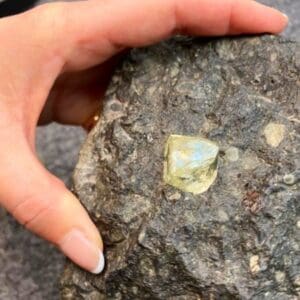Kimberlite is also referred to as blue ground and yellow ground. These stones are dark-colored, heavy, often altered, and brecciated (fragmented). This intrusive igneous rock contains diamonds within its matrix.
The porphyritic texture of Kimberlite contains large, usually rounded crystals (phenocrysts) surrounded by a fine-grained groundmass or matrix.
How To Identify Kimberlite
You’d be surprised by how many emails I receive each month asking me to help identify a supposed piece of Kimberlite. Better yet how about the emails asking me to value a diamond the size of a golf ball when in reality it’s clear Quartz, Slag Glass, or clear Calcite!
Here’s a short list of characteristics Kimberlite displays.
The Texture
Kimberlite has a fine-grained texture that can look crystalline or glassy. We might see large or small chunks of mantle rocks, minerals, and other foreign crystals or rocks (xenoliths) in the stone as well.
The actual rock will have high porosity, so many small spaces or voids should be visible under a microscope.
The Color
Kimberlites that haven’t been decomposed, eroded, or oxidized are commonly called Blue Ground because of their hues, which include slate blue, dark blue-green, greenish, purple, brown, or dark gray to black. While Yellow Ground has been weathered away and displays more yellowish hues than brown, purple, blue, or green.
However, altered Kimberlites are more of a yellowish color because the Magnetite within the rock oxidized to Limonite.
The Hardness
Kimberlites are relatively hard stones, with a hardness between 6 and 7 on the Mohs Hardness Scale.
The Presence of Diamonds & Gems
One of the main reasons Kimberlite fascinates so many is the fact that the material contains small diamonds and other beautiful gems within the rock. Who doesn’t want to know they have a Kimberlite pipe on their property full of precious gemstones? The likelihood of this happening is pretty low, keep that in mind.
Magnetism
Kimberlite stones are magnetic, so we can further identify a specimen by testing its magnetism. If you hold a magnet close to the stone and get a pull, and the other determining factors match, the rock is most likely Kimberlite.

Where Is Kimberlite Found?
Kimberlite can be found on the Earth’s surface but there are locations where mining companies had to dig beneath the surface to access the Kimberlite pipe. If you live in the United States then you’ll be happy to know quite a few states have Kimberlite material but not all Kimberlite has diamonds.
Here’s a list of states known to have Kimberlite; Kentucky, Colorado, Wyoming, and Kansas. I left off Arkansas because it’s the only state that has a semi-active diamond mine. Crater of Diamonds is located on public land which doesn’t allow commercial digging but it does allow individuals to dig for diamonds.
Outside of the U.S. is where most of the Kimberlite pipes are located and where most diamond production comes from. Here’s a short list of countries known to have Kimberlite mines; Russia, South Africa, Brazil, Canada, China, Zimbabwe, Botswana, Australia, Angola, and the Democratic Republic of the Congo.
Cool rockhounding tip: In South Africa, the Pandanus candelabrum, a palm-like tree, seems to prefer growing in the soil above Kimberlite deposits. Seeing this shrubby, palm-like tree may indicate that there are precious stones below.
Kimberlite Magma
Kimberlite, the diamond-bearing rock, is actually a type of volcanic rock that naturally forms deep within the Earth before rising to the surface. There are other rock types incorporated into the magma as it rises through overlying formations that provide the necessary buoyancy for the stone’s long journey up.
Magnetic rocks, like Kimberlite, are brought to the Earth’s surface by volcanic eruptions. Magmas assimilate other minerals (collectively known as xenoliths) during their path upward. Diamonds are among these beautiful xenoliths contained within Kimberlite ore and that is why the majority of diamonds mined today are mined in Kimberlite deposits.

Kimberlite Rocks
So, we know how and where Kimberlite is likely to form but we need to take a minute and talk about the three different ways Kimberlite occurs in the Earth’s surface.
- Crater Kimberlites: These rocks are found within volcanic craters. This variety is a breccia or fragmented rock containing rocks, crystals, and volcanic ash.
- Diatreme Kimberlite: This type of Kimberlite creates a deep funnel or cylindrical-shaped pipe in the Earth called a Diatreme. It’s made up of fragmented rocks and volcanic debris.
- Hypabyssal Kimberlite: This type is found near the Earth’s surface. It’s less fragmented than the first two types of Kimberlite, and it has a porphyritic texture, meaning it contains large crystals surrounded by smaller crystals.

Kimberlite Diamonds
When you think of mining diamonds, you think of Kimberlite because it is the primary source from which diamonds can be found. As Kimberlite is pushed to the surface via magma, diamonds are transported quickly upward by the violent magma eruptions that occurred millions of years ago. Kimberlite diamonds are found in both weathered and unweathered Kimberlite and Lamprolite rocks.
If the eruptions were not violent and quick then the beautiful diamonds would have turned into Graphite. According to scientist’s predictions, the Kimberlite pipes might have traveled somewhere around 20 to 30 mph.
- Identify Enstatite - March 12, 2024
- Identify Cerussite - March 3, 2024
- Identify Bytownite - February 18, 2024
